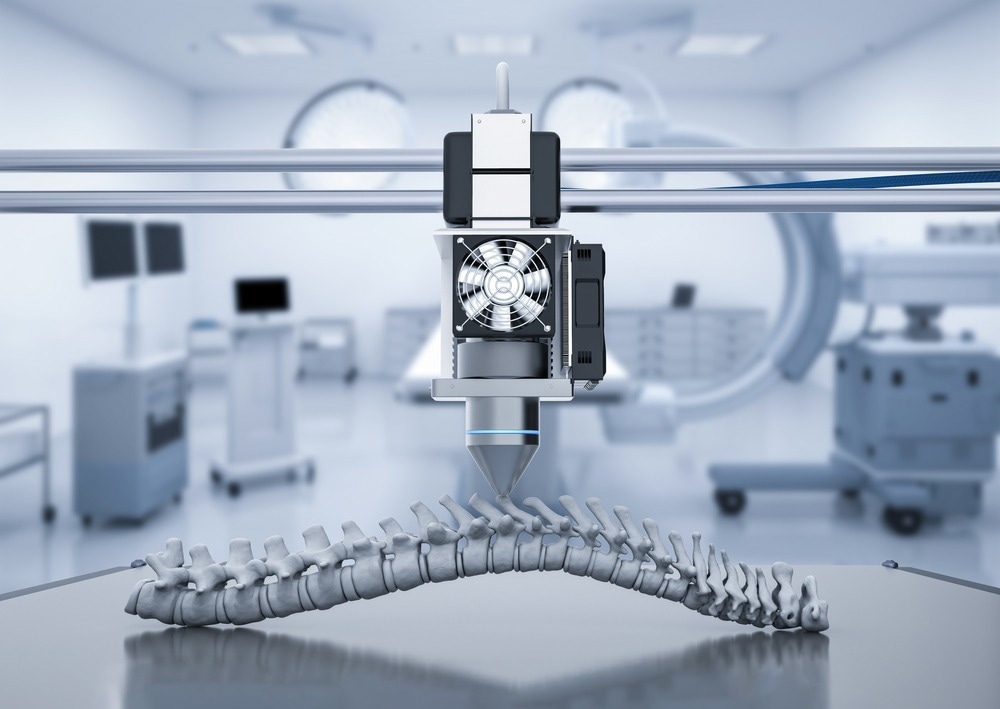In a recent article published in Applied Science, researchers from China investigated the photothermal performance of a composite scaffold containing light-heat-sensitive nanomaterial SiO2@Fe3O4. The scaffold aims to induce controlled internal temperature variations through mild thermal stimulation, promoting osteogenic differentiation and facilitating bone defect repair.

Image Credit: Phonlamai Photo/Shutterstock.com
Background
Bone defects resulting from trauma, disease, or surgical interventions pose significant challenges in orthopedic medicine, necessitating innovative approaches for effective bone tissue regeneration.
Current treatment modalities, such as bone grafts and implants, have limitations in promoting rapid and functional bone healing, especially in complex defect scenarios. Therefore, there is a critical need for advanced biomaterials and scaffolds that can mimic the native bone microenvironment and facilitate accelerated tissue regeneration.
The Current Study
Fe3O4 nanoparticles were synthesized using a co-precipitation method. FeCl3·6H2O and FeSO4·7H2O were dissolved in deionized water, followed by the addition of NH4OH under vigorous stirring. Sodium dodecylbenzene sulfonate (SDBS) was added to stabilize the nanoparticles. The resulting Fe3O4 particles were collected via centrifugation and washed to remove impurities.
The composite scaffold was fabricated using a biological 3D printer. A mixture of polyvinyl alcohol (PVA), hydroxyapatite (HA), β-tricalcium phosphate (β-TCP), polycaprolactone (PCL), and the synthesized Fe3O4 nanoparticles were extruded layer by layer to form the scaffold structure. Specific printing parameters, such as nozzle diameter and printing speed, were optimized to ensure precise scaffold geometry.
X-Ray diffraction (XRD) analysis confirmed the crystal structure of Fe3O4 nanoparticles and the SiO2@Fe3O4 composite. Scanning electron microscopy (SEM) was utilized to examine the scaffold's microstructure, providing insights into pore distribution and interconnectivity. Contact angle measurements were conducted to evaluate the scaffold's surface hydrophilicity.
The composite scaffold's compressive strength was determined using a universal testing machine. Samples were subjected to axial compression at a constant rate to assess their mechanical performance. The results were analyzed to evaluate the scaffold's ability to withstand load-bearing conditions relevant to cancellous bone.
The composite scaffold's photothermal properties were assessed by exposing samples to near-infrared light (808 nm, 2 W/cm2) for a specified duration. Temperature changes were monitored using infrared thermography to quantify the scaffold's ability to generate controlled thermal responses. Different mass fractions of photothermal composite scaffolds were compared to evaluate their photothermal efficiency.
In vitro cell compatibility studies were conducted by seeding bone tissue cells on the scaffold surface. Cell adhesion, proliferation, and viability were assessed using fluorescence microscopy and cell viability assays. The scaffold's ability to support cell growth and maintain a favorable cellular environment was evaluated to determine its biocompatibility.
An orthogonal experimental design was employed to optimize the material composition of the scaffold. Statistical analysis, including analysis of variance (ANOVA) and regression analysis, was performed to identify the significant factors influencing scaffold properties. Data were analyzed using appropriate statistical software to draw meaningful conclusions from the experimental results.
Results and Discussion
XRD analysis confirmed the crystal structure of the Fe3O4 particles, exhibiting characteristic diffraction peaks corresponding to the magnetite phase. The uniform size distribution and stable dispersion of Fe3O4 nanoparticles within the scaffold matrix enhanced the scaffold's photothermal properties.
SEM imaging revealed the composite scaffold's microstructural features, showcasing well-defined pore structures and interconnectivity. The incorporation of photothermal-sensitive nanoparticles resulted in a homogeneously dispersed scaffold with enhanced thermal responsiveness. Contact angle measurements indicated a moderate hydrophilic nature of the scaffold surface, which is favorable for cell adhesion and proliferation.
Mechanical testing demonstrated the superior compressive strength of the composite scaffold, meeting the mechanical property requirements for cancellous bone applications. The scaffold exhibited a compressive strength of 5.722 MPa, indicating its ability to withstand physiological loads and provide structural support for bone tissue regeneration. The optimized material composition contributed to the scaffold's mechanical robustness.
Upon exposure to near-infrared light, the composite scaffold exhibited a rapid temperature elevation within a clinically relevant range (40–43°C) conducive to promoting osteogenic differentiation. The photothermal response of the scaffold was characterized by a temperature increase of 3–6°C within a short duration, highlighting its potential for controlled thermal stimulation in bone tissue engineering applications. The efficient conversion of light energy into heat by the scaffold demonstrated its promising photothermal performance.
Preliminary cell compatibility studies indicated that the composite scaffold supported cell adhesion and proliferation, suggesting its biocompatibility for bone tissue regeneration. The scaffold's surface properties and microstructure provided a conducive environment for cell attachment and growth, essential for promoting tissue regeneration. Further in-depth studies are warranted to evaluate long-term cell responses and tissue integration within the scaffold.
Conclusion
The investigation successfully developed a photothermal composite bone scaffold with promising applications in bone tissue regeneration. The scaffold's ability to induce controlled temperature variations and promote osteogenic differentiation highlights its potential for enhancing bone defect repair.
Further research and development in this area could lead to innovative solutions for orthopedic treatments.
Journal Reference
Shan, C., Xu, Y., Li, S. (2024). Investigation of the Photothermal Performance of the Composite Scaffold Containing Light-Heat-Sensitive Nanomaterial SiO2@Fe3O4. Applied Science. doi.org/10.3390/app1411491